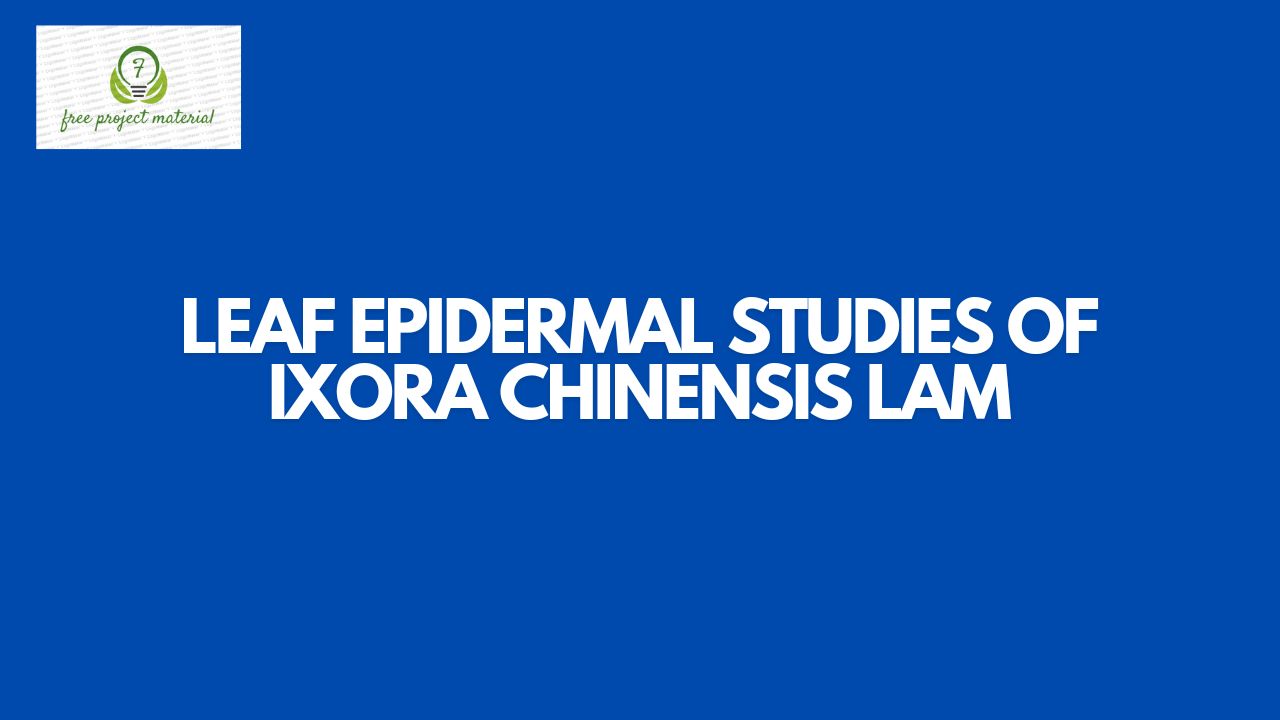ABSTRACT
Ixora chinensis Lam. belong to the Rubiaceae family (Chinese Ixora) and is commonly used traditionally and in folklore medicine in treating various disease. The present study investigated the epidermal characters of Ixora chinensis leaf. The epidermal studies include present of stomata on the abaxial surface (anomocytic) and absent of stomata on the adaxial surface. The anticlinical wall pattern was undulate to straight in both adaxial and abaxial surfaces. Trichomes were absent on both surfaces, epidermal cell shape irregular to polygonal in both surfaces. The presence of the anomocytic stomata was of diagnostic useful in the taxa.
TABLE OF CONTENTS
Title Page – – – – – – – – – i
Certification – – – – – – – – ii
Dedication – – – – – – – – – iii
Acknowledgments – – – – – – – iv
Abstract – – – – – – – – – v
Table of Contents – – – – – – – – vi-viii
CHAPTER ONE: INTRODUCTION
1.1 Background of the Study – – – – –
1.2 Aim and Objectives of the Study – – – –
1.2.1 Aim of the Study – – – – – – –
1.2.2 Objectives of the Study – – – – – –
1..3 Scope and Limitation of the Study – – – –
CHAPTER TWO: LITERATURE REVIEW
2.1 Taxonomical Classification – – – – –
2.2 Taxonomic Description of Ixora chinensis – –
2.2.1 Macroscopy – – – – – – – –
2.2.2 Microscopy – – – – – – –
2.3 Folklore Medicinal Uses/Traditional
Uses of Ixora chinensis – – – – – –
2.4 Phytochemistry of the Plant – – – – –
2.4.1 Anti-Oxidant Activity – – – – – –
2.4.2 Anti-Inflammatory Activity – – – – –
2.4.3 Athelmintic Activity – – – – – –
2.4.4 Anti-asthmatic Activity – – – – – –
2.4.5 Anti-diarrhoael Activity – – – – – –
2.4.6 Hypoglycemic and Hypolipidemic Activity – – –
2.4.7 Hepatoprotective Activity – – – – –
2.4.8 Wound Healing Activity – – – – – –
2.4.9 Antinociceptive Activity – – – – – –
2.4.10 Cytotoxic and Antitumor Activity – – – –
2.4.11 Anti-Ulcer Activity – – – – – –
2.5 Definition of Stomata – – – – – –
2.5.1 Function of Stamata – – – – – –
2.5.2 Types of Stomata – – – – – – –
CHAPTER THREE: MATERIALS AND METHODS
3.1 Materials – – – – – – – –
3.1.1 Sample Collection – – – – – – –
3.2 Methods – – – – – – – –
3.2.1 Anatomical Studies – – – – – –
CHAPTER FOUR: RESULTS AND DISCUSSION
4.1 Results – – – – – – – –
4.2 Discussion – – – – – – – –
CHAPTER FIVE: CONCLUSION AND RECOMMENDATION
5.1 Conclusion – – – – – – – –
5.2 Recommendation – – – – – – –
5.3 Suggestion for Further Studies – – – – –
References
CHAPTER ONE: INTRODUCTION
1.1 Background of the Study
Medicinal plants have been of age long remedies for human diseases because they contain components of therapeutic value (Adegoke et al., 2009). Plants are used in modern medicine where they occupy a very significant place as raw material for important drugs (Audu et al., 2007). Plants are considerably useful and economically essential. They contain active constituents that are used in the treatment of many human diseases. Plant are rich sources of ecologically developed secondary metabolite, which are potential remedies for different ailments.
Ixora is a genus of flowering plant in the Rubiaceae family. There are about 500 species (Nayak et al., 1999). Rubiaceae are easily recognizable and characterized by opposite leaves that are simple and entire with interpetiolar stipules, tubular sympetallous corollas and an inferior ovary.
Eventually there are some plants that have only one single leaf at each node, alternating from one side to the other. In these cases, the alternate leaf arrangement is produced through the suppression of one leaf at each node (Takhtajan, 2009).
Ixora chinensis is evergreen shrub or small trees. Ixora is a genus of flowering plants in the Rubaceae family which contains more than two species but one of them is considered in this research, that is Ixora chinensis.
Pharmacologically, the leaves are reported for their anti-microbial, anti-diarrheal and antinociceptive activities (Annapurna et al., 2003). The flowers possesses antioxidant, anti-inflammatory, wound healing activities (Nayak et al., 1999). Leaves are given in diarrhea and also used in treatment of dysentery, leucorrhea, dysmenorrhea, hemoptysis and catarrhal bronchitis (Ghani, 2003).
In the traditional medicine of India, infusions of the leaves and juice from the roots are used to treat a wide variety of ailments including dysentery, ulcers and gonorrhea (Parreta, 2001).
Patil and Patil (20110 reported on the investigation of foliar epidermis in some Rubiaceae. The foliar epidermal features of Rubiaceae have been documented by Metcalfe and Chalk (1979).
There are further studies by different workers (Mathew and Sucarajan, 1987; Viera et al., 2001; Rathnakuimari et al., 2002 and Tarsila et al., 2009). The ethanolic extract of the plant wax proved to have estrogenic abortifacient and anti-implantatient effects (Singh et al., 1993).
1.2 Aim and Objective of the Study
1.2.1 Aim of the Study
To provide useful taxonomic data that would aids in the proper and easy identification of plant species.
1.2.2 Objectives of the Study
To assess the epidermal characteristics of Ixora chinensis
1.3 Scope and Limitation of the Study
The scope and limitation of this work focus on epidermal features of Ixora chinensis leaf.



